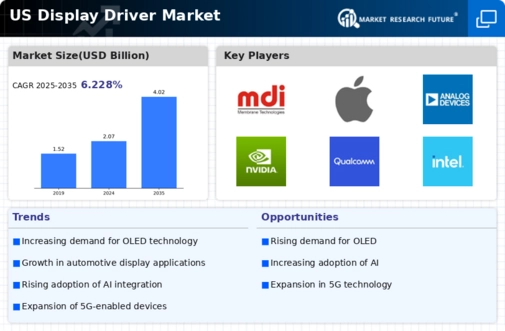Expansion of the Gaming Industry
The display driver market is significantly influenced by the expansion of the gaming industry, which has seen unprecedented growth in recent years. As of 2025, the gaming sector is estimated to generate revenues exceeding $200 billion, creating a substantial demand for high-performance display drivers. Gamers require advanced graphics capabilities, leading to the development of specialized display drivers that can support high refresh rates and low latency. This demand is not limited to traditional gaming consoles but extends to PC gaming and mobile platforms as well. The display driver market is thus poised to benefit from this trend, as manufacturers strive to meet the evolving needs of gamers.
Increased Adoption of Smart Devices
The proliferation of smart devices is a key driver for the display driver market, as these devices require efficient and effective display solutions. In 2025, it is estimated that over 75% of households in the US will own at least one smart device, ranging from smartphones to smart TVs. This widespread adoption necessitates advanced display drivers that can manage various display technologies, including OLED and LCD. The display driver market is adapting to this trend by developing versatile drivers that can cater to multiple device types and display requirements. As smart devices continue to evolve, the demand for innovative display drivers is likely to increase, further fueling market growth.
Rising Demand for Automotive Displays
The automotive sector is increasingly becoming a significant contributor to the display driver market, driven by the rising demand for advanced infotainment systems and digital dashboards. By 2025, it is anticipated that the automotive display market will reach approximately $30 billion, creating a substantial opportunity for display driver manufacturers. As vehicles become more technologically advanced, the need for high-quality displays that provide real-time information and entertainment is paramount. The display driver market is responding to this trend by developing specialized drivers that can support the unique requirements of automotive displays, thereby enhancing the overall driving experience.
Growing Demand for High-Resolution Displays
The display driver market is experiencing a surge in demand for high-resolution displays, driven by consumer preferences for enhanced visual experiences. As technology advances, consumers increasingly seek devices with 4K and 8K resolutions, which necessitate sophisticated display drivers capable of handling the increased data throughput. In 2025, the market for high-resolution displays is projected to account for approximately 35% of the overall display driver market. This trend is particularly evident in sectors such as gaming, where immersive graphics are paramount. Consequently, manufacturers are investing in research and development to create advanced display drivers that can support these high-resolution formats, thereby propelling growth in the display driver market.
Technological Advancements in Display Technologies
Technological advancements in display technologies are reshaping the landscape of the display driver market. Innovations such as flexible displays and microLED technology are emerging, requiring new types of display drivers that can accommodate these cutting-edge formats. In 2025, the market for flexible displays is projected to grow by over 20%, indicating a strong demand for compatible display drivers. The display driver market must keep pace with these advancements to ensure compatibility and performance. As manufacturers invest in R&D to create drivers that support these new technologies, the overall market is expected to experience robust growth, driven by the need for innovation.






















Leave a Comment